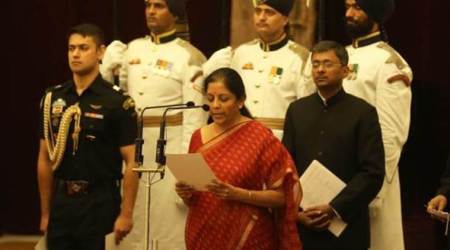 Nirmala Sitharaman being sworn-in as a Cabinet Minister by President Ram Nath Kovind at Rashtrapati Bhavan in New Delhi on Sunday. Pic By Neeraj Priyadarshi.030917
Nirmala Sitharaman being sworn-in as a Cabinet Minister by President Ram Nath Kovind at Rashtrapati Bhavan in New Delhi on Sunday. Pic By Neeraj Priyadarshi.030917
Once the attention shifts from new Defence Minister Nirmala Sitharaman’s gender — she is the first woman defence minister, discounting Indira Gandhi who was also PM when she held the defence portfolio — she will be judged according to how well she implements a reforms roadmap that is already in place.
Sitharaman is the second full-time defence minister in the NDA government, after Manohar Parrikar, with Arun Jaitley holding the portfolio for six months in between. During his 16-month tenure, Parrikar identified various areas that needed reform, foremost being tackling delays in procurement and streamlining a process to promote ‘Make in India’. He approved the new Defence Procurement Procedure last year; it was completed with Jaitley finalising its chapter on Strategic Partnership model, the cornerstone of furthering indigenous defence manufacturing in the private sector. The defence services have already started preparing and issuing requests for information (RFI), the first stage of procurement, under the model: the Navy issued one for helicopters while the Air Force will soon issue an RFI for single-engine fighter jets. Sitharaman will count on her experience as commerce minister in guiding the process of choosing an SP.
Related to that is the question of speeding up modernisation of the armed forces. This relates not only to foreign suppliers — Parrikar bought 36 Rafales after prolonged negotiations — but also to domestic producers, which include the Defence Public Sector Units (DPSUs). The CAG, the parliamentary standing committee and the armed forces have been crtical about the performance of DPSUs and ordnance factories. Many reports on the action plan to reform each DPSU and ordnance factory lie in the ministry’s cabinets; all eyes will be on how soon Sitharaman brings them out and finds a way to act on them.
The recent crisis at Doklam had once again highlighted the gaps in infrastructure on the Indian side of the China border. In the past three years, the government has given the defence ministry full control of the Border Roads Organisation and enhanced their financial powers, but the pace of road construction has not picked up. Besides, for strategic railway lines on the border, even project reports have not been completed. It will be incumbent upon the new minister to give a fresh impetus to creation of this infrastructure.
For a new defence minister, the most challenging aspect is of matters internal to the defence services. By Parrikar’s own admission, it took him a few months before he could understand the services as an organisation, their ethos and their requirements. Controversies such as Pay Commission recommendations, One Rank One Pension, and status of military officers vis-à-vis their civilian counterparts could resurface at any time. The three service chiefs, however, seem to be in sync with the ministry on most issues; this will allow Sitharaman some time to come to terms with these politically sensitive matters.
Two of her biggest challenges will be undertaking higher defence reforms and getting a greater share of budgetary resources for the ministry. Defence spending as a percentage of GDP is at levels lower than before 1962, and the bulk of it is for revenue expenses such as salaries. Some of the recommendations of the Shekatkar Committee, formed by Parrikar, were accepted by Jaitley and those internal to the Army are being implemented now.
Some of the major recommendations that will come up before Sitharaman pertain to higher defence organisation – formation of a single military commander or of integrated theatre commands — which require balancing the interests of various civilian and military institutions.
Most defence ministers have figured in the top four in the seniority list of the cabinet while Sitharaman is second-last. It will be up to her to prove her critics wrong in the next 20 months.
